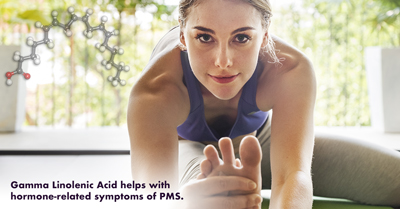For PMS, supplementing Gamma Linolenic Acid (GLA) stabilizes hormone-related symptoms and calms inflammation. Women who suffer PMS are known to have low levels of GLA, a unique omega-6 fatty acid. They may additionally have problems processing essential fats to generate enough of the ‘good’ prostaglandins which have an essential role in reducing inflammation. For PMS that is caused by inflammation, GLA gives excellent relief of symptoms.
 Omega-6 fatty acids are very common in standard American diets, but GLA is much less commonly consumed; we need supplemental GLA since our bodies may not be able to form it from food. Although its precursor, linoleic acid, is found in nuts, seeds, and vegetable oils, its conversion into GLA can be hampered by disorders like diabetes, the natural aging process, poor diet including excess saturated fats or sugar, or inadequate intake of vitamin C, magnesium, zinc, or B-complex vitamins. Women unable to adequately convert linoleic acid to GLA, would therefore have more inflammatory prostaglandins which could worsen PMS symptoms.
Omega-6 fatty acids are very common in standard American diets, but GLA is much less commonly consumed; we need supplemental GLA since our bodies may not be able to form it from food. Although its precursor, linoleic acid, is found in nuts, seeds, and vegetable oils, its conversion into GLA can be hampered by disorders like diabetes, the natural aging process, poor diet including excess saturated fats or sugar, or inadequate intake of vitamin C, magnesium, zinc, or B-complex vitamins. Women unable to adequately convert linoleic acid to GLA, would therefore have more inflammatory prostaglandins which could worsen PMS symptoms.
From GLA, the body forms prostaglandin E1 and the thromboxane A1, both of which can reduce inflammation, inhibit the formation of pro-inflammatory leukotrienes, improve blood flow, and inhibit platelet clumping. Prostaglandin E1 also has a role in regulation of healthy immune system function. As early as 1995, there was so much interest in the potential of GLA for medical use, that the Health and Nutrition Division of the American Oil Chemists’ Society convened an international conference to examine the biological value of GLA. This meeting brought together world-renowned experts who explored in-depth the biochemistry, metabolism, nutritional, and clinical uses of GLA. This conference examined hundreds of studies and launched an equal number examining its mechanism of action and anti-inflammatory benefits, and resulted in a book that summarized the studies to date.1
Studies show that a sufficient daily intake of between 200-1,000mg of GLA is needed for all the important breast, skin and anti-inflammatory benefits. In our clinic, we have seen high-dose GLA give excellent relief of PMS and menopausal symptoms; and breast tenderness from benign causes: PMS, fibrocystic breast problems, or perimenopause.
Evening primrose oil may be recommended for PMS because it has GLA, but most sources have relatively low amounts, so we sought out a product that would meet the proper dosage in a bioavailable format. We find a super-high concentrate to be far more effective, requiring fewer capsules, and thus more economical. Two capsules of a concentrate of GLA containing 240-250mg GLA per capsule provide as much GLA as twelve capsules of 500mg evening primrose oil, or six capsules of 500mg blackcurrant oil. We recommend our patients take between 240 to 960mg daily with any meals, either for two weeks of the month for PMS, or daily for other benign breast discomfort.
Recommendations:
240 to 960mg GLA, Gamma Linolenic Acid daily for seven to fourteen days before and seven days after each period starts, or as directed by your healthcare provider. Changes can be seen after one to three months of use.
References
- Mills, David E. Gamma-linolenic acid: Metabolism and its roles in nutrition and medicine. AOCS Publishing, 1996
- Fan YY, Chapkin RS. Importance of dietary gamma-linolenic acid in human health and nutrition. J Nutr 1998;128:1411-4.
- Guivernau M, Meza N, Barja P, Roman O. Clinical and experimental study on the long-term effect of dietary gamma-linolenic acid on plasma lipids, platelet aggregation, thromboxane formation, and prostacyclin production. Prostaglandins Leukot Essent Fatty Acids 1994;51:311-6.
- Johnson MM, Swan DD, Surette ME. Dietary supplementation with gamma-linolenic acid alters fatty acid content and eicosanoid production in healthy humans. J Nutr 1997;127:1435-44.
- Ryu A, Kim TH. Premenstrual syndrome: A mini review. Maturitas. 2015 Dec;82(4):436-40. Epub 2015 Aug 28.